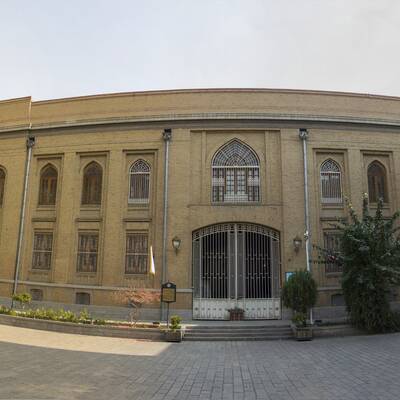Malik Library-Museum is a significant treasury of the lasting artistic and cultural history of Iran. Being established by Haj Hossein Malek’s investment, Malik Museum is now located inside the area of National Garden in a historic texture of the city Tehran. It was firstly used as just a library until 1343 S.H. when the deceased Haj Malik decided to add a museum including historically and artistically invaluable objects to his library in order to make easily accessible the manifestations of Persian art and culture to the foreign scholars, according to him, and establish a museum which can compete with the best museums around the world.
The complex includes a selected collection of the masterpieces of Persian art such as the paintings related to different cultural and historical periods, lacquered art, and the calligraphy of the precious manuscripts, lithography, carpet, stamp, and the unique collections of coins. It can be said that Mohammad Zaman lacquered pencil case is worthy enough to give the museum a universal authenticity. Mohammad Zaman was the cause of some innovations in his time and we are the inheritors of this way of thinking about art. His novelty is in so far leading as it made a profound gap between him and his predecessors. This pencil case was the only work made by Mohammad Zaman which is exhibited to the public in Iran. Most of his other works are now kept in the great foreign collections and museums where they aren’t allowed to be introduced because the collectors are deeply concerned about their safety.
The wonders of Malik Museum
There also exists another pencil case in the museum made by Mahmoud Khan Malik-ol Shoara. Mahmoud Khan, one of the geniuses of old Iran, was an assorted and informed person opened up a new world for the next artists. Add to all beauties of this museum the original picture of Khorshid Khanom (lady sun) painted by Sani ol molk, Abul Hasan Ghaffari; a painter who is placed in our visual memory. Other works kept in this museum are a self-portrait of Kamal-ol-Molk, Mohammad Ghaffari, painted using an artful style, the valuable works of Mir Emad’s calligraphy, Baysonghori Shahnameh, and lithography illustrations of Mirza Aligholi Khoee. Other masterpieces of this museum are the famous Baysonghori Quran and Baysonghori Shahnameh and Bahram Shahi Kelileh va Demneh. The oldest Quran in Malik Museum, which is one of the main treasuries of the museum, is attributed to Imam Hasan Mojtaba (peace be upon him) stamped by Shah Ismail I, consisted of several pages of Quran which is not completed. There also exist some handwritten Qurans with gilded covers, Shahnameh and Khamseh Nezami written by Mohammad ibn Motahhar-e Neishaburi commissioned by Soltan Baysonghor with a folio containing the scene of offering Shahnameh and the date of writing, 837 A.H.
The museum has two floors; the ground floor dedicated to the coins of the pre-history, Islamic and contemporary eras. In other sectors, the Persian paintings particularly Qajar paintings by the famous artists like Sani ol Molk Kamal-ol-Molk are showcased.
Seven Precious Collections
Malik National Museum embraces seven collections: coin collection, artworks collection, lacquered artworks collection, stamp collection, carpet collection, lady Malik collection, and calligraphy collection. The collection of coins in Malik Museum includes 3000 Persian coins and medals related to a time span between the 6th century B.C. to Pahlavi period, in addition to some coins from the Greek, belonging to Alexander’s successors, Byzantine Empire, Islamic rulers and Ottoman Empire. The second collection includes painting tableaus by Iranian artists named Kamal-ol-Molk Ghaffari, Lotflai Suratgar, Hadi Khan Tajvidi and some of European painters. In the lacquered collection you can see the pencil case and mirror frame with a 300-years history. A collection of stamps from the early published samples in Iran and the world to the contemporary items have been gathered in the stamp collection of Malik Museum. Maybe the most precious among the museum artworks is the carpet collection consisted of several handwoven carpets of the most skillful weavers during two last centuries. Qajar painting tableaus, manuscripts, pencil cases, lacquered items and tobacco bowls are waiting for you in the collection of lady Malik. And finally, the calligraphy collection embraces the artworks of the greatest and the most famous calligraphers of Iran like Yaqut Mostasemi, Alireza Abbasi, Mir Emad, Ahmad Neirizi, Darvish Abdolmajid Taleqani, Mirza Golamreza Isfahani.
The Great Treasury of Persian Manuscripts
Embracing 19000 precious and unique manuscripts, Malik Library is one of the six great treasuries of manuscripts in the world. Moreover, the library contains about 70000 printed books, 3400 lithography books and 548 periodical journals in 4000 volumes. A main part of the printed books is belonged to years before 1320 S.H. and they are among the first printed books in Iran. Students and scholars can use searching services for the specific information in the website, data base and English electronic information resource bank of the museum. Also, you can find you required data on the digital library of Malik and reserve your desired books.

















